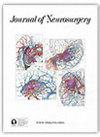Association of rare variants in RNF213 with severe progression of intracranial artery stenosis in quasi-moyamoya disease.
IF 3.5
2区 医学
Q1 CLINICAL NEUROLOGY
引用次数: 0
Abstract
OBJECTIVE The genetic basis underlying the pathophysiology of quasi-moyamoya disease (qMMD) is unclear. Herein, the authors aimed to comprehensively analyze genetic variants in qMMD and investigate their association with clinical phenotypes, focusing on RNF213 and other moyamoya angiopathy (MMA)-related genes. METHODS The authors evaluated 14 consecutive cases of qMMD, whose underlying conditions included autoimmune disease, head irradiation, meningitis/pachymeningitis, and Turner syndrome, and 9 cases of hyperthyroidism-associated MMD (hMMD). The frequencies of RNF213 p.Arg4810Lys in qMMD and hMMD were each compared to those in healthy controls and in patients with MMD. Whole-exome sequencing was performed, and rare variants (RVs) or damaging variants were analyzed in RNF213 and 36 MMA-related genes. RESULTS The frequencies of p.Arg4810Lys were significantly higher in patients with qMMD (28.6%) and hMMD (33.3%) than in controls (1.1%; p < 0.001) and lower in the two former groups than in the MMD group (67.6%; p = 0.003 and 0.065, respectively). In qMMD, no significant clinical differences were observed based on the presence of p.Arg4810Lys. A novel RNF213 RV was identified in four cases with qMMD. These same cases also presented with significant worsening of intracranial main artery stenosis, which suggests a possible association between RNF213 RVs and the severe progression of qMMD. Among the 36 MMA-related genes, no variants correlated with specific phenotypes. CONCLUSIONS While the clinical implications of p.Arg4810Lys in cases with qMMD were not identified, the study findings suggest a potential association between RNF213 RVs and the significant progression of intracranial artery stenosis. Genetic analysis should not focus solely on p.Arg4810Lys but instead consider a comprehensive analysis of RNF213 for more accurate clinical prognostication of qMMD.RNF213的罕见变异与准莫亚莫亚病颅内动脉狭窄的严重恶化有关。
目的准moyamoya病(qMMD)病理生理学的遗传基础尚不清楚。在此,作者旨在全面分析 qMMD 的遗传变异,并研究它们与临床表型的关联,重点是 RNF213 和其他莫亚莫亚血管病(MMA)相关基因。方法作者评估了 14 例连续的 qMMD 病例(其基础疾病包括自身免疫性疾病、头部照射、脑膜炎/脑膜脑炎和特纳综合征)和 9 例甲状腺功能亢进相关 MMD(hMMD)病例。将qMMD和hMMD中RNF213 p.Arg4810Lys的频率分别与健康对照组和MMD患者的频率进行了比较。结果p.Arg4810Lys在qMMD患者(28.6%)和hMMD患者(33.3%)中的频率明显高于对照组(1.1%;p<0.001),在前两组中的频率低于MMD组(67.6%;p=0.003和0.065)。在qMMD中,没有观察到基于p.Arg4810Lys存在的明显临床差异。在 4 例 qMMD 患者中发现了一种新型 RNF213 RV。这些病例的颅内主动脉狭窄也明显恶化,这表明 RNF213 RV 与 qMMD 的严重恶化之间可能存在关联。结论虽然没有发现 p.Arg4810Lys 在 qMMD 病例中的临床意义,但研究结果表明 RNF213 RV 与颅内动脉狭窄的严重恶化之间可能存在关联。基因分析不应只关注p.Arg4810Lys,而应考虑对RNF213进行全面分析,以更准确地预测qMMD的临床预后。
本文章由计算机程序翻译,如有差异,请以英文原文为准。
求助全文
约1分钟内获得全文
求助全文
来源期刊

Journal of neurosurgery
医学-临床神经学
CiteScore
7.20
自引率
7.30%
发文量
1003
审稿时长
1 months
期刊介绍:
The Journal of Neurosurgery, Journal of Neurosurgery: Spine, Journal of Neurosurgery: Pediatrics, and Neurosurgical Focus are devoted to the publication of original works relating primarily to neurosurgery, including studies in clinical neurophysiology, organic neurology, ophthalmology, radiology, pathology, and molecular biology. The Editors and Editorial Boards encourage submission of clinical and laboratory studies. Other manuscripts accepted for review include technical notes on instruments or equipment that are innovative or useful to clinicians and researchers in the field of neuroscience; papers describing unusual cases; manuscripts on historical persons or events related to neurosurgery; and in Neurosurgical Focus, occasional reviews. Letters to the Editor commenting on articles recently published in the Journal of Neurosurgery, Journal of Neurosurgery: Spine, and Journal of Neurosurgery: Pediatrics are welcome.
 求助内容:
求助内容: 应助结果提醒方式:
应助结果提醒方式:


